As I think most of you know, a team of University of Michigan architects and their graduate students were approached some time ago and asked to envision what a new Water Street recreation center might look. Having completed their design concepts, they will be presenting their work to the citizens of Ypsilanti at SPARK East this Thursday afternoon. In preparation for that, I submitted a number of questions. Following are their responses, accompanied by images of their work…
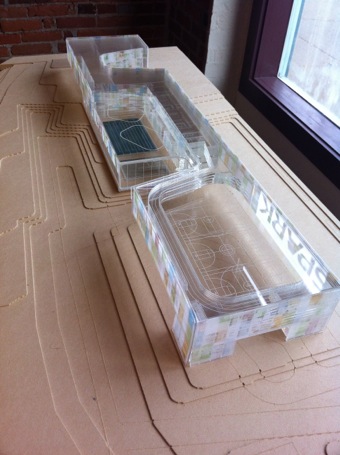 Perhaps, to start, it would make sense to ask how your team became engaged in this project to begin with. Who reached out to you, and how did they present the task?
Perhaps, to start, it would make sense to ask how your team became engaged in this project to begin with. Who reached out to you, and how did they present the task?
Our involvement was initiated when Robert Marans, Washtenaw County Parks Commission President and Emeritus Professor of Architecture & Urban Planning at the University of Michigan, contacted the Taubman College of Architecture and Urban Planning regarding the project. He was specifically interested in approaching faculty who were engaged in collaborative practice between architecture and urban planning and who were interested in including students in the work. Craig Borum pursued this initial inquiry and invited Maria Arquero and Jen Maigret to join in a collaboration to bring together his expertise in architecture and construction systems with Maria and Jen’s expertise in sustainable urban practices. Our student team comprised of a mixture of architecture and urban planning graduate students from the University of Michigan.
Can you tell us a little about yourselves, your backgrounds, the student team that you worked with, etc?
The design team, led by Professor of Architecture Craig Borum, includes Assistant Professor of Architecture Jen Maigret, and Assistant Professor of Architecture and Urban and Regional Planning Maria Arquero. This team brings together expertise in the integration and synthesis of knowledge through professional practice experience and scholarly research. The collaboration of the three faculty members extends through teaching, practice and research over the last few years. Professors Borum, Maigret and Arquero have co-taught courses at the graduate level, and are currently collaborating in a series of research projects in the region.
Professor Borum’s design research has garnered considerable accolades for digital fabrication, material practice and, most recently, research that engages climate and atmosphere related to glass construction practices. Borum has focused his research and creative practice at the scale of construction practices and material logics as they challenge predominant modes of architectural practice. His work has, and continues to explore the intersection of geometry and materiality with the scope of both research efforts and commissioned projects. His specific contribution to the discipline of architecture stems from the integration of technical advancements in the description and materialization of building geometries –made possible by computational processes- into built work.
His research is lodged in both investigative and traditional logics of materials, construction techniques, and systems of architectural enclosure (walls, doors, and window systems). His creative practice has substantially contributed to a broader understanding of implications of sustainable thinking on architectural design by offering an alternative to the discursive monoculture of LEED Certification and other formulaic top-down approaches. His approach builds upon recent theoretical speculation on atmospheric effects in a manner that goes beyond their phenomenological and technical implications of material assemblies through an understanding and positioning of the iconography and ideology of materials and tectonics within the architectural discipline.
Assistant Professors Arquero’s and Maigret’s body of research and practice lies at the intersection of urban and regional design, landscape architecture and architecture. Arquero and Maigret are concurrently developing techniques in the representation of regional and metropolitan systems, the analysis of interconnected, geospatial networks, and material practices that prioritize environmental performance and cultural tradition within expanded disciplinary territories. To date, their work has developed a particular expertise in the Great Lakes Region, surrounding links between regionalism and innovative urban stormwater management techniques, and revealing the unique cultural and material heritage around water in the identity of the region. Pursuing an interest to cross-register temporal and physical scales and engage the rich cultural identity of the region, Arquero and Maigret are currently engaged in a series of research initiatives towards the development of more sustainable patterns of urbanization in the city of Detroit. Their most recent research involves place-based design initiatives that prioritize the potential of interconnections between open public space, community capacity building and environmental stewardship.
The student team involved with this project includes:
Catherine Baldwin, MArch, 2012
Leigh Davis, MUP, 2013
Kathryn Dreitzler, MArch, 2014
Chaerin Jin, MUP, 2013
Kayla Lim, B.S.Arch 2010 (U-M), current student at Harvard University, MArch, 2014
Caileigh MacKellar, MArch 2012 McGill University
Amy McNamara, MArch, 2007
Geoffrey Salvatore, MArch, 2013
Alex Timmer, B.S.Arch 2009 (U-M), current student at Harvard University MArch, 2015
Catherine Truong, MArch, 2013
You can access all of our cv’s on the Taubman College website.
Also, you can find more information at the websites of our firms: PLY Architecture and MAde studio.
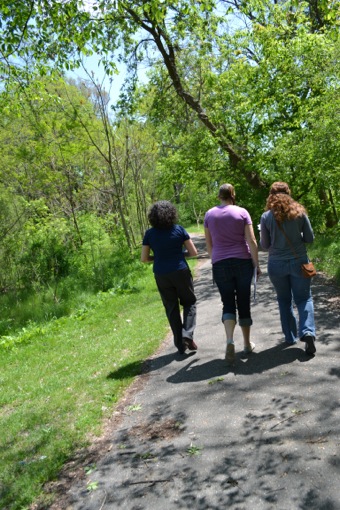 What can you tell us about your process? I’m assuming, for instance, that, before you started, you walked the site, visited other recreation centers, interviewed people in the community, etc., right?
What can you tell us about your process? I’m assuming, for instance, that, before you started, you walked the site, visited other recreation centers, interviewed people in the community, etc., right?
The design process started in May, and has undergone different phases. We started with the compilation and analysis of the information on site conditions. Throughout that time, and since then, we have visited the site frequently to document the current conditions, and to better understand the relationship and transitions between the river and the downtown. We have used photography to capture particular aspects of the natural and constructed environments that are important in our approach to site. This site, in particular, is very rich and layered due to its industrial history, urban adjacency and greenway river corridor. On two occasions, the Washtenaw County Parks and Recreation coordinated walks on the site and on other occasions, although anecdotal, we learned about the importance of the river as an active destination from the individuals we encountered. It is also evident that the site is currently challenging to access and that improved connectivity with Riverside and Waterworks Park are desired. Furthermore, due to the potential to connect indoor activities with outdoor activities and because of the importance of the trees in the river landscape, the site is unusual and exceptional, as compared with other recreation center sites that we visited. Working with the still recent memory of the industrial past of the site provides a poetic opportunity to reclaim the site for public use.
As part of our program research, we toured several regional recreation centers as a way to better understand how each recreation center served the specific needs of its community members. We provided information at the recent Heritage Festival during which time the Washtenaw County Parks and Recreation Department distributed a program survey to gain additional feedback from community members about what makes Ypsilanti’s needs unique and how its recreation center can best serve those needs.
We visited a series of recreational centers in the region, interviewed programming, business and facilities managers to hear about the strengths and challenges of the recreation centers they knew well. We were also able to obtain several floor plans of other recreation centers, which enabled us to study program sizes, distribution and general approaches to the organization of circulation and activities. Throughout the entire project, we are greatly indebted to the generosity of Cathy Duchon, director of the Ann Arbor YMCA, who attended the recreation center site visits and design project meetings and whose feedback has been invaluable in the development of the design schemes.
Before we talk about your designs, perhaps you could share your thoughts concerning Ypsi’s existing urban form, the natural features that we have to work with, and how both of those things guided your thinking.
This is an interesting question for us because the context of the site has been one of the main drivers in both of the designs. Urban form is one important component of that, but there is also a rich set of narratives that enliven city spaces and in the case of Ypsilanti, these arise out of a number of interesting sources, including a historic plan, designed by the Olmstead Brothers, for an “emerald necklace” of parks and public spaces along the Huron River. These drawings are on display at Ypsilanti’s City Hall and played a part in reminding us of the longstanding commitment that the City of Ypsilanti has had towards a vision of an integrated, sustainable urbanism.
Someone recently pointed out to me that the term “Rec Center,” could mean a lot of different things. What are the specific needs you’re looking to serve with this project? And how have those particular needs affected what’s gone into the design concepts that you’re proposing? Also, I’m curious as to what you’ve chosen to leave out.
We started with a very inclusive definition of “user”, as the recreational center is located in the very core of Ypsilanti. The idea that this cosmopolitan civic facility has the potential to attract a wide range of residents is one of the most fascinating aspects of the proposal. In this sense, this facility will cater to professionals and families and offer programming for all ages. This wide range of users demands a flexible programming of the space, both inside and out, under the promise to serve as a new civic anchor for the community. The primary program presented in both recreation center design schemes includes two pools (one lap Swimming pool with a cooler temperature, and a second, open water, warmer temperature pool), cardio and weight-lifting areas, a gym (comprised of half courts that can be separated for multiple, simultaneous activities), a multi-lane banked track, multipurpose rooms (including space for workout group classes and yoga), and a child-watch area.
Beyond active programs, the recreational center aims to bring people together and create a sense of community. In this particular case, the Rec Center is also responsible to foster imagination and trigger future development in Water Street. Given its unique location, the Center will grant public access and continuity to both the Municipal Historical Park System and the regional Huron Valley green network. The Recreational Center has a tactical location that serves as a transition from the historical downtown to the rich riverine landscape, and sets grounds for future development of a former industrial site in the heart of the city.

What did you perceive to be the most significant challenges? Clearly you’ve got things to contend with, in a geographic sense, like the river, the flood plain, the access from Michigan Avenue, but you’ve also got to consider the fact that you might well be setting the tone for the next 100 years in this City, right?
This project is challenging in a number of ways, and the decisions made about approaches to an environmentally sensitive site that has an important economic, urban and cultural role in Ypsilanti are critical to setting a tone for the kind of development that can be fostered within the Water Street site. Economic desires are sometimes seen to be at odds with environmental sensitivity, however, in the case of the recreation center, the challenge of working along the river and within a portion of a flood plain represents an opportunity to create a building that is a model of sustainable urbanism.
This is even more challenging and important given the public nature of the recreation center and the activities it hosts both within the building as well as on the grounds of its site. In this way, one of the most exciting spatial challenges of the project is to link access from the Border-to-Border trail along the river with access from vehicular parking and from pedestrian, bike and bus traffic along Michigan Avenue. In both schemes, we accomplished this kind of connectivity and ensured that the entry to the recreation center would be urban, accessible and visually tied to the river while ensuring that only a single check in desk would be necessary to maintain security and customer service.
Speaking of the flood plain, the first design for this development, some 12 years ago, when it was in the hands of a private developer, called for a great deal of soil to be trucked in, altering the natural topography of the site. The reasoning, I suspect, was that more land above the 100 year flood plane meant more buildable lots, which, in turn, translated into to more money for the developer. Given our earlier conversations, it sounds as though you’ve rejected this idea. Why?
We strongly believe that it is a mistake to build on this site without taking the responsibility of water management seriously. Many of our current water infrastructure challenges, including frequent over-capacity of combined sewer systems, is due to the accumulated effects of short-sighted approaches to flood plains and urban materiality. In many cases, the short term economic “bump” from more buildable lots results in an overall infrastructural expense that far exceeds the gain. If the expenses of dams, combined sewer overflows and wastewater treatment plants were taken into account, our approaches to urban construction would change significantly in its approach to water. In this way, it is critical that on sites, such as Water Street, the approach to building does not displace water, but rather accommodates rain water as a resource rather than “waste.” Anything other than this approach risks the integrity of the larger river system rather than taking advantage of this challenge to construct a forward- looking truly sustainable example of a twenty-first century public building.
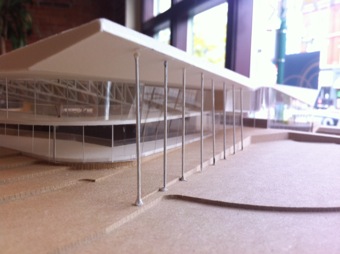 You have two primary designs. Can you tell us about each of them, what their individual advantages are, and how they differ from one another?
You have two primary designs. Can you tell us about each of them, what their individual advantages are, and how they differ from one another?
Our approach to this project has been to develop two schemes, each of which prioritizes a different set of opportunities emerging from the intersection of the Huron River greenway system and Michigan Avenue.
“The Canopy” presents a recreation center that is an architectural extension of the canopy of trees on the riverfront site. The ground of this scheme forms a constructed landscape that generously accommodates the program of the building while the floating canopy roof above defines and connects the spaces underneath. The organization of this scheme centralizes the program of the recreation center and allows for views of and between the pools, check-in and gym activities, as well as to the river and park beyond. The elevated track allows one to travel through the depth of the canopy roof structure above, moving through the gym and entry spaces with constantly changing views between inside activities below and elevated views of nature outside. Glass, with white, fritted patterns of trees, forms the enclosure of the recreation center. The elevation facing Michigan Avenue integrates a generous sidewalk that allows pedestrians along Michigan Avenue to move under the roof canopy and see through the upper portion of the gym and track thereby participating in the visual life of the center. The elevation that faces the river is civic in scale while functioning like a porch for visitors to gather together. It brings a portion of the Border-to-Border trail under the canopy roof and past an entry point before returning back to the portion of the trail that follows the River. In all of these ways, “The Canopy” Recreation Center is an extension of the park system that serves as a welcoming gateway between the city and the park. “The Canopy” Recreation Center promotes social interactivity, transparency to the city, and a connection to the Border to Border trail.
“The Storefront” presents a recreation center that is an extension of the scale and visual patterns of the urban fabric of Michigan Avenue. This scheme takes inspiration from both the meandering Huron River and the historical character of nearby storefronts. “The Storefront” Recreation Center stretches out along the length of the River, touching down at the northern end of the site along Michigan Avenue and elevating above of the ground towards the southern end of the site, providing a sheltered exterior gathering space below. The entry area is organized around a public plaza that links Michigan Avenue and the Border-to-Border trail under the northern corner of the building. This is a project that fosters dispersed social spaces that provide a sense of discovery as one travels through the separated spaces. Additionally, two exterior rooftop “lily pads” allow for small exercise classes and events to spill out onto the second floor green roof. The track in this project starts at the climbing wall, circles the gym and has continuous glimpses through the skin of the building out to the River, the rest of the Water Street site and into a rainwater courtyard. The elevation facing Michigan Avenue touches down to the west and allows for pedestrians to move under an upper level of workout spaces towards the entry doors. Long portions of the elevation that face the Huron River are clear glass in order to connect views from inside to outside. The activity spaces along the riverfront side include the pool, cardio spaces and the gym. The façade borrows directly from the patterns and rhythms of Ypsilanti’s downtown storefronts and uses contemporary, double-skin construction systems that maximize natural daylight while providing energy efficiency. The façade honors both history and the present while balancing transparency with privacy.
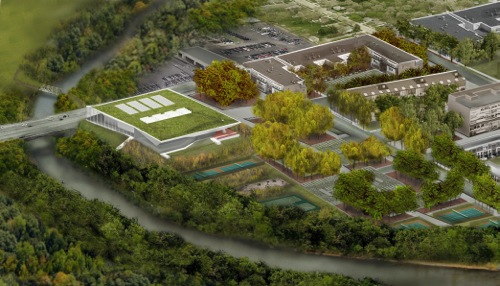
The City is primarily on a grid system, with the Huron River curling through it. How did the related urban form, in particular the City’s substantial historic district, walkable downtown, and nearby neighborhoods, inform the design of the site and building?
Both schemes mediate the transition between the gridded urban system, along Michigan Avenue, and the gently meandering natural systems along the Huron River. Across the entire Water Street site, the urban grid scheme continues the existing urban block scale of Ypsilanti while using a variety of building typologies and siting strategies to accommodate differences between interior, urban blocks and the perimeter river blocks. In contrast, the ribbon urban scheme recognizes Michigan Avenue and the Huron River as the two distinct resources of the site. It therefore uses the strategy of historic ribbon farms to establish blocks that have access to both river and urban entities. Both urban schemes propose strategies for public spaces and complete streets that integrate sustainable stormwater management techniques, generous street tree plantings and active recreation pocket parks. The resulting scale and organization of streets and public spaces foster walkability, encourage connectivity with the river and recognize that the Water Street’s site most important asset is its citizens and the quality of life that can emerge from a contemporary, sustainable approach to urbanism.
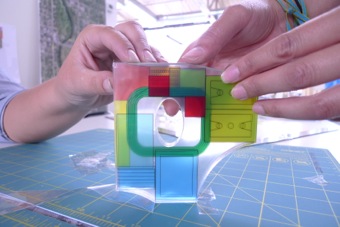 When you were approached to do this project, you were told, as I understand it, that you had 12 acres to work with, on the westernmost side of the parcel. (The entire parcel is 38 acres.) As you may know, there’s been a bit of push-back from some in the community, who feel as though this development, as it’s not going to generate tax revenue for the City directly, should be relegated to a “less desirable” part of the parcel, further away from downtown, and further off Michigan Avenue. While I know that this isn’t ultimately your decision, I was curious if you could tell me, in your opinion, why it might make sense to put the rec center on the end of the parcel closest to the heart of downtown.
When you were approached to do this project, you were told, as I understand it, that you had 12 acres to work with, on the westernmost side of the parcel. (The entire parcel is 38 acres.) As you may know, there’s been a bit of push-back from some in the community, who feel as though this development, as it’s not going to generate tax revenue for the City directly, should be relegated to a “less desirable” part of the parcel, further away from downtown, and further off Michigan Avenue. While I know that this isn’t ultimately your decision, I was curious if you could tell me, in your opinion, why it might make sense to put the rec center on the end of the parcel closest to the heart of downtown.
The parcel designated for the recreation center is the most appropriate site within the Water Street redevelopment area for two primary reasons. The first is that at the heart of every great city lies a commitment and vision for civic, public space that fosters connections between its people and the natural systems of a place. Ypsilanti has already shown its commitment to establishing an outstanding greenway system along the Huron River that has the potential to link these public, natural spaces with the cultural activities of its downtown. Siting a recreation center at the intersection between the Huron River Greenway system and the Michigan Avenue corridor reinforces a commitment to community and offers the possibility of augmenting indoor recreation activities with outdoor recreational spaces. The second reason that this site is more appropriate for a recreation center than other forms of development is that the site itself is not the most valuable parcel in the Water Street redevelopment area (as determined by independent real estate consultants hired by the City of Ypsilanti) due to its difficult topography, the existence of a flooplain area and the difficulty, if not impossibility of establishing an appropriate curb cut for vehicular traffic. The recreation center schemes deal with these challenges both by concentrating the buildable area in a portion smaller than 12 acres and by bringing vehicular access through the curb cuts and streets to be constructed to support the rest of the development.
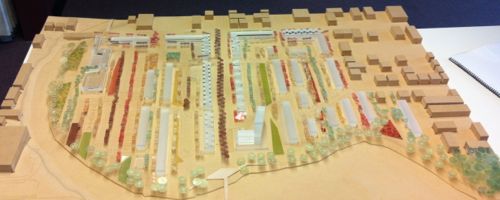
Unless I’m mistaken, while you were primarily engaged to consider what the rec center might look like, you also spent a good deal of time thinking about the master plan for the entire parcel. I’m curious as to the assumptions you started with. For instance, as you know, the City, given how much we’ve invested, needs to make a certain amount of money back in the way of taxes for this development to make fiscal sense, and I’m wondering to what extent that influenced your work. In other words, I’m curious to what extent you might have worked backwards from that tax revenue dollar amount to determine things like density, and the mix of residential and retail on the site.
One of the exercises we did with the students was a financial analysis to better understand the existing market conditions that will factor into the future Water Street development. For this study, we used available data on land value, site preparation cost estimates, and other real estate indicators. We also studied some of the previous plans for the site to better understand the aspirations of the city and the business community prior to the 2008 crisis. All of the work done, by others, in previous analyses was tremendously useful to establish some basic assumptions that guided some basic attributes of our urban design schemes.
We developed two different scenarios, each with slightly different compositions of residential unit numbers and commercial square footage. Each of the two urban schemes also propose different approaches to public space and access to urban amenities in order to better gain feedback surrounding what would be most valued by the community. From these initial numbers, we decided to “build out” the model that was predicted to be the most profitable. To give you a sense of what these numbers guided, we designed massing strategies (for both the grid and ribbon schemes) to accommodate roughly 400 housing units (ranging from 1 to 3 bedrooms), and a series of commercial components including retail, office and a hotel.
The financial proforma looks at a ten-year period to understand profitability, and gives some ideas of how to create manageable units of development, distribute densities, and capitalize on the frontage to the river (on the south end of the site, as we mentioned earlier, the east edge is a difficult development site) and Michigan Avenue. We assimilated these elements to craft an approach to site that builds on mixed use strategies to ensure a diversity of uses across the site, interspersed with public parks and recreation activity spaces. In these ways, the financial information guided our approach towards the careful design of the public realm to ensure a balance between optimum economic, social and environmental performance.
The site we’re talking about, as you know, is sandwiched in between the very popular Riverside Park and the very underused Waterworks Park. How much time have you spent looking at the way people use those parks (or how they could use those parks), and how has that affected your thinking about the rec center building and the site?
While we did not spend a great deal of time studying Riverside Park and Waterworks Park in particular, both urban approaches recognize the importance of extending the River Street corridor in an urban, pedestrian friendly way in order to allow for the activities north of the site to spill through the site and across the Huron River. In the grid approach, this is accomplished through a proposed boulevard and plaza space along the River’s edge that opens up and constructs a visual connection with Waterworks park. In the ribbon scheme, this is accomplished with a ribbon of trees that extend through the entire site and link with a new bridge crossing and plaza space for the Border to Border Trail.
As for the rec center itself, how big is it, what have you included, and how does it stack up when compared to other rec centers in the area?
Both of the recreation center schemes are approximately 65,000 square feet. Compared with other recreation centers that provide gym and cardio spaces, a track and two pools, it is modest in its size. For comparison’s sake, it is smaller than the Detroit YMCA (100,000 sf), the Spartan Stores YMCA (86,000 sf) and the Ann Arbor YMCA (71,000 sf) while it is larger than the Meri Lou Murray Recreation Center (56,000 sf).
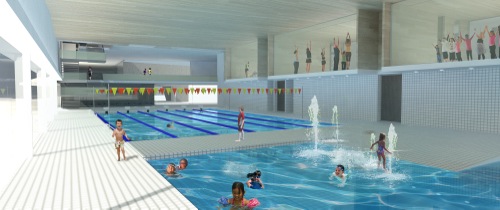
There are, as you know, other design firms that just design and build recreation centers. From what I can tell, they’re typically just dropped into greenfields, like the new Washtenaw Community College Recreation Center, and don’t integrate well with their surroundings, but one would imagine they’re relatively inexpensive, and not terribly risky. Why, in your opinion, is it important, in this instance, to go with something that’s not just “off the shelf”?
The Eastside Recreation Center project deserves a site-specific approach that catalyzes the unique opportunities that it represents. The site requires an specific approach that recognizes the need for a transition between historic and new development and urban and natural systems. A generic approach cannot accomplish this nor can it bring innovative thinking to the level of specificity required of integrated, sustainable design. Furthermore, a generic approach would not necessarily be either less expensive nor less risky due to the amount of site work that would be required to produce a “neutral” tabula rasa and the consequences of constructing a recreation center surrounded by parking and asphalt on such an environmentally sensitive site. Overall, we believe that good architecture, and therefore good urbanism must instead show an appreciation for the complexity of existing conditions along Michigan Avenue and be of this place rather than of “no” place.
Could you tell us how the Border to Border bike trail factored into your design?
In both schemes that we are presenting, incorporating the Border to Border trail has been a prominent design goal. The trail is integrated into the exterior circulation and even weaves under the physical overhang of the building. Both Rec center schemes are conceived of as part of the Border to Border trail, versus remaining autonomous from the recreation center development. Our design proposals enhance the desirability of the trail by serving as attractive destination spots with outdoor activities and outdoor park spaces to gather and enjoy the river setting. We hope that as the site is beautified with parks and civic spaces, that more people will use the trail.
As I understand it, you’ll be holding two public meetings later this week, during which you’ll show these designs, and answering questions… When and where will these meetings be taking place?
The information about the two schemes and the urban approaches will be on display at the SPARK East Business Incubator at 215 W. Michigan Avenue, Ypsilanti between September 26-28, 2012. We will be available for questions and conversation between 3pm and 8pm on Thursday, September 27 and will be giving two presentations, the first at 4pm and a second at 7pm.
What happens next? Who ultimately signs off of the designs? And, assuming they do, then what happens?
This question would be best asked of the Washtenaw County Parks Department, who will be present at the SPARK presentation to address questions that we cannot.
Southeast Michigan doesn’t have much in the way of what you might call cutting edge contemporary architecture. Assuming one of your designs gets built, do you think it’s likely that it could be a cultural draw in perpetuity, as well as being a useful counterpoint to the design tone of the rest of the city?
We truly believe that this building bears a great responsibility of setting the tone for the future development within the Water Street Redevelopment Area and for establishing an expectation for the quality of materials and spaces that contemporary civic life merits.
One last thing… What kinds of materials will you be suggesting?
The projects have developed approaches towards materiality such as relative levels of transparency and layering. The materials that we have represented in the concept designs include glass, steel, brick, powder coated metal panels (sometimes perforated) and landscape materials to construct low maintenance, water-absorbing public plaza spaces.


 MARK: Let’s start with your name, OK?
MARK: Let’s start with your name, OK?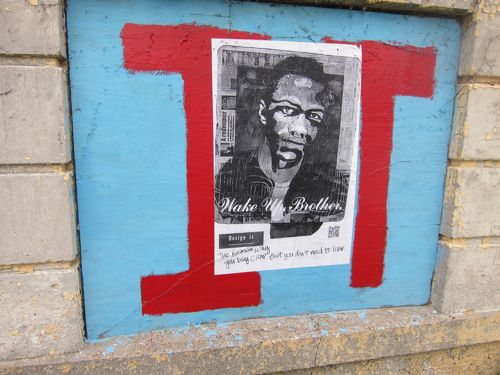
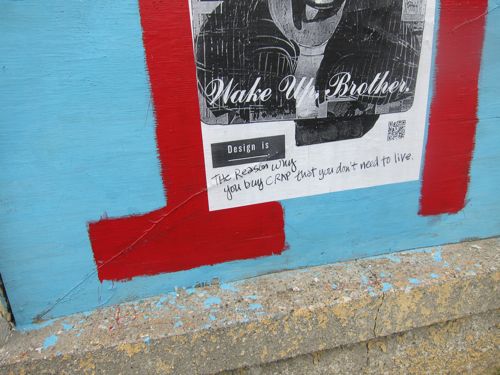
 A few days ago, in
A few days ago, in 









